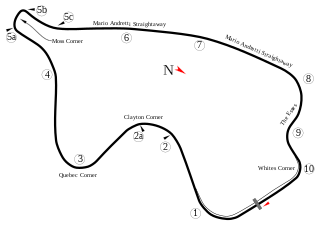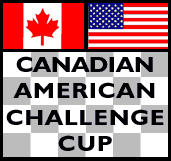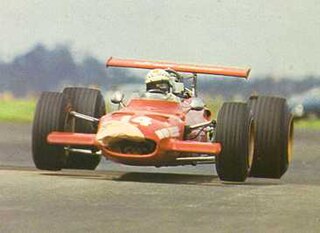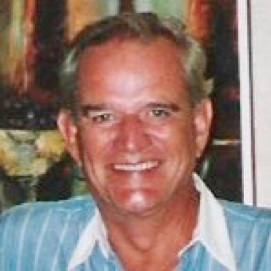
Canadian Tire Motorsport Park is a multi-track motorsport venue located north of Bowmanville, in Ontario, Canada, 64-kilometre (40 mi) east of Toronto. The facility features a 3.957 km (2.459 mi), 10-turn road course; a 2.9 km (1.8 mi) advance driver and race driver training facility with a 0.402 km (0.250 mi) skid pad and a 1.5 km (0.93 mi) kart track. The name "Mosport", a portmanteau of Motor Sport, came from the enterprise formed to build the track.
Warwick Brown is a former racing driver from Australia.

Mark Neary Donohue Jr., nicknamed "Captain Nice," and later "Dark Monohue," was an American race car driver and engineer known for his ability to set up his own race car as well as driving it to victories.

The Canadian-American Challenge Cup, or Can-Am, was an SCCA/CASC sports car racing series from 1966 to 1987.

Formula 5000 was an open wheel, single seater auto-racing formula that ran in different series in various regions around the world from 1968 to 1982. It was originally intended as a low-cost series aimed at open-wheel racing cars that no longer fit into any particular formula. The '5000' denomination comes from the maximum 5.0 litre engine capacity allowed in the cars, although many cars ran with smaller engines. Manufacturers included McLaren, Eagle, March, Lola, Lotus, Elfin, Matich and Chevron.

Edmonton International Speedway, also known as Speedway Park, was a 251-acre (1.02 km2) multi-track auto racing facility located in the present Cumberland and Hudson neighbourhoods of Edmonton, Alberta, Canada. The facility featured a 1⁄4-mile (400 m) dragstrip, a 2.53-mile (4.07 km) 14-turn road course, and a 1⁄4-mile short oval. At its peak, it had capacity for over 30,000 fans.

Graeme Lawrence is a race car driver from New Zealand. He started serious motor racing in the National 1.5 litre series winning the series decisively in 1968 ahead of David Oxton and Ken Smith. Lawrence then ran half a European F2 series in an uncompetitive semi works F2 McLaren, he found the racing harder than expected and was shaken, by his experience racing in Germany at the Hockenheim race in the rain, were Jim Clark was killed. McLaren allowed Lawrence to build up another F2 chassis in his works and was 2nd in the SR Gold Star series in the car, and first ST driver home in the Tasman races at Pukekohe and Levin.

Johnnie Walker is a former Australian racing driver, born in Adelaide, South Australia. He first raced in the early 1960s at Mallala in his Holden FE road car. After competing in the Australian Formula 2 Championship he graduated to Formula 5000 in 1972, driving an Elfin MR5 and a Matich A50 before switching to the Lola marque in late 1973.
Horst Kwech was an Australian race car driver, race car constructor, engineer and inventor known primarily for his several wins in the early Trans-Am Series races of the 1960s and the beginning of the 1970s.
Charles W. "Chuck" Parsons was an American sports car racing driver. Parsons drove in SCCA and USSRC competition, then became a driver in the Can Am series. Like many drivers of the era, he participated in multiple venues, such as the 24 Hours of Daytona and 24 Hours of Le Mans endurance races while driving the same year in the Can Am series.
The 1977 Can Am season was the tenth running of the Sports Car Club of America's prototype-based series. Despite the revived name, however, the new series was entirely unrelated to the previous series which had folded in 1974. Most of the competitive cars were based on Formula 5000 chassis. Also, the first time under 2-litre cars were allowed to race, but with no separate class. Patrick Tambay was declared champion, winning six of the nine races that year for Carl Haas. While Lola chassis dominated the series, a Chevrolet powered Schkee DB1 driven by Tom Klausler won the first race at Mont Tremblant. Other competitive cars included the 1974 champions Shadow, who now used Dodge engines and Wolf with a Dallara-built chassis. While Chevrolet was not the only engine supplier, they swept the entire season. This season also marked a resurgence of interest in SCCA events, with Can Am accompanying F5000 and the Trans Am Series seeing a mild resurgence in the eighties.
The 1978 Can-Am season was the eleventh running of the Sports Car Club of America's prototype based series and the second running of the revived series. Alan Jones was declared champion, winning five of the ten rounds. Chevrolet again swept the season. Lola was not as dominant this season, as Elliot Forbes-Robinson won at Charlotte in a Spyder, SCCA legend George Follmer at Mont Tremblant in a Prophet, and Forbes-Robinson again at Trois-Rivieres.
The 1974 SCCA/USAC Formula 5000 Championship was the eighth running of the Sports Car Club of America's premier open wheel racing series. It was the first to be sanctioned jointly by the Sports Car Club of America (SCCA) and the United States Auto Club (USAC), and the first to be held under the "SCCA /USAC Formula 5000 Championship" name. Sponsorship by the L&M cigarette brand was not carried forward from the 1973 championship.
The 1975 SCCA/USAC Formula 5000 Championship was the ninth running of the Sports Car Club of America's professional open wheel automobile racing series and the second to be sanctioned jointly by the Sports Car Club of America and the United States Automobile Club. The championship was open to cars complying with the SCCA's 5 litre American stock block engine specifications and to cars complying with the USAC's 161 cid turbocharged, 255 cid DOHC or 320 cid stock block engine regulations.
The 1976 SCCA/USAC Formula 5000 Championship was the tenth running of the Sports Car Club of America's premier open wheel racing series and the third to be co-sanctioned by the Sports Car Club of America (SCCA) and the United States Auto Club (USAC).

Bill Freeman was a professional racing driver, race team owner, motorsport racing enthusiast, race car manufacturer, and business entrepreneur.
Keith Holland is a British former racing driver from England who competed in various classes of racing in the 1960s and 1970s. He is known for winning the 1969 Madrid Grand Prix in a Formula 5000 car in a field which contained several Formula One entries. He was also a regular competitor in the European Formula 5000 Championship finishing third in the title standings on two occasions.
Bernard James "B. J." Swanson was an American racing driver. Born in Fort Wayne, Indiana, he was the son of Mr & Mrs Bernard Swanson Jr. He lost his life while competing in a Formula 5000 race, in 1975.
Gerald Jon 'Jerry' Hansen is a former racing driver. Hansen has won a record of 27 SCCA National Championships. Hansen has also competed in Can-Am, the Atlantic Championship, USAC ChampCar among other series.
The Frissbee GR2 and Frissbee GR3 were American sports prototype racing cars, built by Frissbee in 1981 and 1982, respectively, for the Can-Am series. Originally built by Lola Cars as a Lola T332 Formula 5000 car; and featured a 5-liter Chevrolet V8 engine. It was then converted into the Spyder Can-Am car in California, raced for Newman-Freeman racing, and was driven by Keke Rosberg among others. It eventually evolved into its current iteration, and was later driven by Danny Sullivan, Robert Meyer, Al Unser Jr., Jacques Villeneuve, Sr., Horst Kroll and Rick Miaskiewicz, between 1982 and 1985. It was later sold to Colin Poole of Plum Tree Racing in England and competed there between 1987 and 1989.







